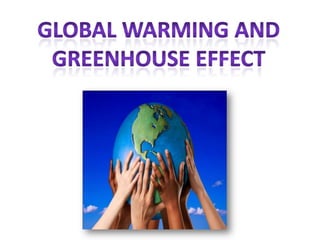
Global warming and greenhouse effect
- 2. Global warming is the rising average temperature of Earth’s atmosphere and oceans since the late 19th century and its projected continuation. Since the early 20th century, Earth's average surface temperature has increased by about 0.8 C (1.4 F), with about two thirds of the increase occurring since 1980. Warming of the climate system is unequivocal, and scientists are more than 90% certain that most of it is caused by increasing concentrations of greenhouse gases produced by human activities such as deforestation and the burning of fossil fuel. An increase in global temperature will cause sea levels to rise and will change the amount and pattern of precipitation, and a probable expansion of subtropical deserts. Warming is expected to be strongest in the Arctic and would be associated with continuing retreat of glaciers, permafrost and sea ice. Other likely effects of the warming include more frequent occurrence of extreme-weather events including heat waves, droughts and heavy rainfall ,species extinctions due to shifting temperature regimes, and changes in crop yields. Warming and related changes will vary from region to region around the globe, with projections being more robust in some areas than others. Hence, the ecosystem services upon which human livelihoods depend would not be preserved.
- 5. Initial causes of temperature changes Greenhouse effect schematic showing energy flows between space, the atmosphere, and earth's surface. Energy exchanges are expressed in watts per square meter (W/m2).
- 6. Greenhouse gases The greenhouse effect is the process by which absorption and emission of infrared radiation by gases in the atmosphere warm a planet's lower atmosphere and surface. Naturally occurring amounts of greenhouse gases have a mean warming effect of about 33 C(59 F).The major greenhouse gases are water vapor, which causes about 36–70% of the greenhouse effect; carbon dioxide (CO2), which causes 9–26%; methane (CH4), which causes 4–9%; and ozone (O3), which causes 3–7%. Human activity since the Industrial Revolution has increased the amount of greenhouse gases in the atmosphere, leading to increased radiative forcing from CO2, methane, tropospheric ozone, CFCs and nitrous oxides. Fossil fuel burning has produced about three-quarters of the increase in CO2 from human activity over the past 20 years. The rest of this increase is caused mostly by changes in land-use, particularly deforestation. CO2emissions are continuing to rise due to the burning of fossil fuels and land-use change. Emissions scenarios, estimates of changes in future emission levels of greenhouse gases, have been projected that depend upon uncertain economic, sociological, technological, and natural developments. In most scenarios, emissions continue to rise over the century, while in a few, emissions are reduced. Fossil fuel reserves are abundant, and will not limit carbon emissions in the 21st century. Emission scenarios, combined with modeling of the carbon cycle, have been used to produce estimates of how atmospheric concentrations of greenhouse gases might change in the future. Reduced stratospheric ozone has had a slight cooling influence on surface temperatures, while increased tropospheric ozone has had a somewhat larger warming effect.
- 7. Particulates and soot The climatic impacts from particulate forcing could have a large effect on climate through the indirect effect. Global dimming, a gradual reduction in the amount of global direct irradiance at the Earth's surface, was observed. The main cause of this dimming is particulates produced by volcanoes and human made pollutants, which exerts a cooling effect by increasing the reflection of incoming sunlight. The effects of the products of fossil fuel combustion – CO2 and aerosols – have largely offset one another in recent decades, so that net warming has been due to the increase in non-CO2 greenhouse gases such as methane. Carbon dioxide has a lifetime of a century or more, and as such, changes in particulate concentrations will only delay climate changes due to carbon dioxide. Sulfates act as cloud condensation nuclei and thus lead to clouds that have more and smaller cloud droplets. These clouds reflect solar radiation more efficiently than clouds with fewer and larger droplets, known as the Twomey effect. This effect also causes droplets to be of more uniform size, which reduces growth of raindrops and makes the cloud more reflective to incoming sunlight, known as the Albrecht effect. Indirect effects are most noticeable in marine stratiform clouds, and have very little radiative effect on convective clouds. Soot may cool or warm the surface, depending on whether it is airborne or deposited. Atmospheric soot directly absorb solar radiation, which heats the atmosphere and cools the surface. When deposited, especially on glaciers or on ice in arctic regions, the lower surface albedo can also directly heat the surface. The influences of particulates, including black carbon, are most pronounced in the tropics and sub-tropics, particularly in Asia, while the effects of greenhouse gases are dominant in the extratropics and southern hemisphere.
- 8. Solar activity Solar variations causing changes in solar radiation energy reaching the Earth have been the cause of past climate changes. The effect of changes in solar forcing in recent decades is uncertain, but small, with some studies showing a slight cooling effect, while others studies suggest a slight warming effect. Greenhouse gases and solar forcing affect temperatures in different ways. While both increased solar activity and increased greenhouse gases are expected to warm the troposphere, an increase in solar activity should warm the stratosphere while an increase in greenhouse gases should cool the stratosphere. The magnetic activity of the sun deflects cosmic rays that may influence the generation of cloud condensation nuclei and thereby affect the climate. The influence of cosmic rays on cloud cover is about a factor of 100 lower than needed to explain the observed changes in clouds or to be a significant contributor to present-day climate change. It's worth noting, because this provides unequivocal evidence that the sun is not the dominant driver of global warming. The sun is not nearly the biggest factor in global warming. It is more evidence that greenhouse gases are the largest culprit.
